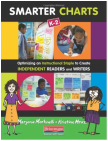 This is the time of year that teachers are getting their rooms ready for their students to begin the next school year. We have been taught that our classrooms should be "print rich" and to some, this means "let's put up a lot of cute "stuff" and fancy bulletin boards, but; I have a question for you to reflect on. How is what you are putting on your walls and on your bulletin boards helping to create independent readers, writers and thinkers? If you cannot effectively answer this question, it's time to rethink what you are putting on your walls. The article Children and Place: Reggio Emilia's Environment As Third Teacher (Strong-Wilson and Ellis, 2007) describes the walls as a third teacher in the classroom. We are in the age of teacher created materials and we see lots of cute and creative things all over teachers-pay-teachers and other site that teachers can use to aid their teaching and make their classrooms pleasing to the eye. I just have a word of caution about what, how, and how much to doing when working with this "third teacher". Kristine Mraz and Marjorie Martinelli wrote a book in 2012 titled: " Smarter Charts". This book offers some helpful tips for the charts and tools that you place on your classroom walls. They say effective charts:
Anchor Charts are tools that support the visual learner and reinforce learning of students with other learning styles. Visual Learning Theory tells us that if students have a visual that represents something they have learned they can better synthesize that learning. Mraz and Martinelli also talk about different types of charts in their book. The charts fall into these categories:
Martinelli, M. & Mraz, K. (2012). Smarter charts, K-2. Portsmouth, NH: Heinemann.
0 Comments
I have been blogging since June of this year. I can only say that I have been consistent in updating every Sunday evening. I am experimenting with different ways to get this blog some exposure and I have also been experimenting with what types of topics I should write about each week. My original purpose was just to have a sort of written chronically of what is happening week to week as I pursue my doctorate so, I have topics like; balance, transitions, and my fears of failing a class as I matriculate through each class. I have also writing briefly about journal articles and books I have read in the last few months. I have noticed that I get more views when I write academically. I am exploring the idea of writing biweekly so that I can do both, (personal and professional) as I continue to investigate what will be my writing style.
Classes begin for the fall semester tomorrow. I am a little anxious, but I am ready to get started so that I can compartmentalize everything that I will need to do to balance my fall work load for both my career and my doctorate course work. I have registered for a professional writing course and a reading research course. I am truly excited about this course work because I feel like I am really learning lots of practical information that I can see myself sharing with the teachers that I coach. (right now it appears that I will have about 18 teachers that I will work with each week as often as I can.) As it stands now, my two courses will meet every other week on Monday's and Thursday's from 4:30-10:00. I am sure that means that I will have some long exhausting days and will certainly need to keep a good balance between work and school. This semester will not be easy but I am working toward a goal and this is the next step in me getting there. I'm updating this weeks blog on my cell phone, from the passengers side of my car. It's move in day at my 19 year old's college dorm. My 18 year old went away a week ago. This year I turned 46 and became an empty-nester. It feels kinda funny and very different. My world has kinda revolved around these children and what they need since my ex-husband passed away. more than 5 years ago. Now the gradual release of responsibility has begun. This is one of the reasons I decided that this was a good time to start my doctoral pursuit. This year has proven to be a year of transition. I've just completed my first full year out of the classroom as an instructional specialist. I've learned a lot. My job didn't really get busy until the teachers ended school for the summer. This summer I discovered what really can be my calling so, I've learned that I have a new interest to pursue. My goal is moving towards teacher training of new teachers and teaching teachers at the college level. I am still focusing on reading and literacy but my job has a more broad focus now that includes all core subjects, because my department has gone through a reorganization. I wasn't really expecting that but change is inevitable at the level I am on. I have decided that I will keep my options open and will continue to explore them. It may be time for a career path adjustment. As with anything in my life I've learned that flexibly is key.
I have another week off of course work and then begins my fall semester of class. Karen J Kindle wrote an article in The Reading Teacher in 2009 titled: "Vocabulary Development During Read-Alouds: Primary Practices." This article brought out some key points that I would like to share with you today. (My blog post this week is not class related but it is something that I can share with the K-2 teachers I will work with this school year. As an elementary school teacher, if you are not already doing read-alouds with your students, you should be. Read-alouds are proven to be an effective way to give vocabulary instruction. Read-alouds help build oral language skills, early literacy skills, and are a good means of developing rich vocabulary. Read-alouds help expose children to different words, and richer text than they would encounter by just reading their Basel and or their decodable readers. Wide reading, reading of lots of different texts is a good way to aid in vocabulary acquisition. The teacher needs only to consider these three things to get started with building vocabulary:
It is important to note that the way books are shared with students matters. Teachers should create conversations between themselves, the text, and the students by the questions and comments they interject as they read. Research is not clear as to how effective different types of questions during read-alouds are so just as a rule of thumb, be on purpose and intentional when doing a read-aloud for your students. Active involvement in the discussion is more noticeable than the types of questions that you ask. Here are some instructional strategies mentioned in the article that may help you focus your read-alouds:
Kindle, Karen J. "Vocabulary Development During Read-Alouds: Primary Practices". The Reading Teacher 63.3 (2009): 202-211. Web. This week I read an article titled: "Culturally Diverse Literature: Enriching Variety in an Era of Common Core State Standards by Fenice B. Boyd, Lauren L. Causey, and Lee Galda. The article spoke about why it is important to integrate culturally diverse literature in to our teaching. It opens by speaking of a Ted Talk from a Nigerian storyteller named Chimamanda Adichie (The Danger of the Single Story) she tell of how she was an early reader and writer from a middle class family but she would write stories about what she read about in books, (white blue eyed characters who played in the snow and ate apples) She truly had only one point of reference, the one that came from the books she read. A single story creates stereotypes and the problem with stereotypes is that they are incomplete and one sided. Stories matter. Children are impressionable and hearing and reading about people from other races, backgrounds, and culture as well as hearing and reading about their own culture helps take them away from the thought that the world is one sided. We need culturally diverse poems, stories, and informational text. It's important to know that the books we offer children to read will affect their world as well as their lives. There are still not enough books being published that are not about the white middle class, heterosexual world and we still live in a society where about 80% of educators are still middle class white females. As of 2010, the US population breaks down like this:
Culturally Diverse Literature: Enriching Variety in and Era of Common Core State Standards From the Reading Teacher Written by Fenice B. Boyd, Lauren L. Causey, and Lee Galda |
AuthorPearl Garden, Ed.D has completed her dissertation research involving understanding the vocabulary instruction practices of early grade teachers. She has a passion for the new and novice educator, and it is her goal to help educators tackle the achievement gap with her research findings. She will use this blog to share what she has learned in “pearls of literacy”. The ideas come from her dissertation titled “A Content Analysis of the Vocabulary Instruction Habits by Early Grade Teachers”. Archives
January 2024
Categories |

 RSS Feed
RSS Feed